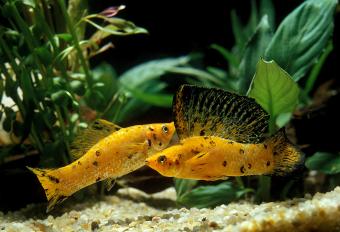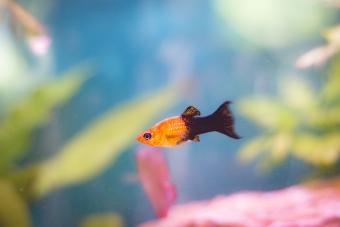
Guppies (Poecilia reticulata) are one of the most popular, diverse, and easy-to-keep freshwater aquarium fish. The length of the guppy gestation period ranges from 21 to 31 days, which is incredibly convenient because it allows them, and us as responsible fish parents, prepare for caring for a large family of guppy fry.
How to Spot a Pregnant Guppy
Female guppies can get pregnant as early as one month old in a warm tank, although the usual maturity age is three months. The key to understanding a guppy's gestation period is knowing if she is, in fact, pregnant. It may be difficult to tell if a guppy is pregnant right away, but after a week or so, you should notice some telltale signs.
The Guppy Gravid Spot Darkens
The guppy gravid spot is a dark triangular spot near the anus at the back of the abdomen under the tail. This spot will darken and enlarge in pregnant females and continue to do so until she gives birth.
Your Guppy Will Grow Larger
A pregnant guppy will also appear to grow larger with a bulky, boxy shape, but this may not be apparent until near the end of her pregnancy. You may notice she has some difficulty with swimming as well. After all, she does have to carry that belly around now. I'm not sure about you, but I know when I was pregnant, I had a bit of a waddle.
Fry Eyes May Be Visible
Toward the end of the pregnancy, the small eyes of the fry may also be visible through the female's thin, translucent belly skin, particularly near the gravid spot. The gravid spot will appear almost black, which is due to the fry eyes. This does sound kind of creepy, but it's not as awkward as it sounds.
Pregnant Guppy Stages and Gestation
The gestation period for guppies will vary based on the female's health, her stress level, and the conditions of her tank. Gestation may last from 21 to 31 days, although 22 to 26 days is average for most guppy pregnancies. There are several stages from fertilization to birth.
- Day 0: The male guppy inseminates the female, potentially resulting in a pregnancy.
- Day 1-7: You likely won't be able to tell if your guppy is pregnant during this initial period. The gravid spot is there, but it's generally not dark enough to notice.
- Day 7-10: By day 10, you should be able to see the gravid spot. You will also notice your guppy's belly begins to expand during this stage.
- Day 10-18: Your guppy's belly will continue to grow, becoming significantly larger than normal. The gravid spot becomes much darker.
- Day 18-25: The guppy is now at their most vulnerable point, being viewed as prey due to the difficulties they experience when swimming.
- Day 25-31: These are the final days of guppy pregnancy. Watch for signs of labor during this period. Your guppy is about to give birth.
Although it isn't overly common, your guppy could give birth as early as 21 days into their pregnancy.
Guppies Giving Birth
Toward the end of the gestation period, guppy breeders may choose to move the female into a birthing tank to protect the fry when they are born.

Dangers to Guppy Fry
A stressed or hungry female may eat her own fry, and guppy fry are a delicacy to many other fish. They're like a bite-size snack for the bigger fish in your tank, and yes, even to their mama fish. Keep this in mind while setting up the tank you'll keep them in.
Birthing Tanks for Female Guppies
If a breeder has been able to keep track of the dates of the gestation period, it can be easy to know when to move the female to a birthing tank. However, it should be noted that doing so can also cause stress that might harm the parent or fry.
If you plan to breed your guppy, putting the breeders in a separate tank and moving the male fish instead of the female could be significantly easier on the mother guppy.
Signs a Female Guppy Is Ready to Give Birth
When the female is ready to give birth, she may grow still and slow in the tank or seek out a solitary spot, but these are not always reliable indicators of the impending birth. It may take a few hours for the female to drop all the fry, and one drop can have as few as two to as many as 200 fry at once, although the average is for a female to give birth to 30 to 60 baby guppies with each pregnancy.
Additional Factors to Keep in Mind
Even if their pregnancy wasn't planned, we want our fish to be healthy. There are several factors to keep in mind in regard to guppy pregnancy and birth. Each factor plays a large role in their well-being.
- Tank temperature: A warmer tank — between 77° to 79°F (25° to 26°C) — is best for gestation and will keep the female from being pregnant too long.
- Stress and anxiety: If she is stressed or feels there is danger, a female guppy may stay pregnant longer, although excessive stress can also shorten the gestation period and cause a miscarriage or spontaneous abortion.
- Appropriate care: Proper pregnancy care is essential for your guppy's health.
- Protection from illness: To protect the female during her pregnancy, the tank should be kept at a consistent temperature and cleaned regularly to avoid any illnesses that can affect the development of the fry or the success of the pregnancy.
- Diet: A healthy diet with a high-quality fish food is also essential to encourage breeding and ensure healthy guppy babies.
Starting the Guppy Gestation Period Again
A female guppy can become pregnant again just hours after giving birth, which has given these highly fertile fish the nickname "million fish." Female guppies have the ability to store sperm from males for up to a year, and they can have up to eight pregnancies from one insemination if they are healthy and have good tank conditions.
Since these fish can get pregnant so young and may live up to three years, and because the gestation period for guppies is just under a month, a single female guppy may have 2,000 or more babies in her lifetime. By understanding her gestation period and the best way to care for a pregnant guppy, fish hobbyists can enjoy raising these fish for years to come.







